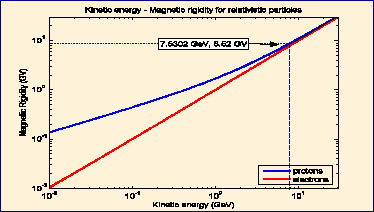Solar Cosmic Rays
Energetic particles of solar origin (mostly protons, He and some heavier nuclei) with energies ranging from some hundreds of MeVs/nucleon up to several GeVs/nucleon (on rare occasions) are called Solar Cosmic Rays (SCR). Solar particles of energy bigger than 100 MeV/nucleon are also known as Solar Energetic Particles (SEPs). The sources of SCRs can be either solar flares or Coronal Mass Ejections (CMEs) and Interplanetary Shocks. The SCR Composition is similar to that of galactic cosmic rays (GCRs): mostly protons, about 10% of He and <1% heavier elements.
On the basis of a simple model, according to which solar cosmic rays produced at the sun propagate inside the interplanetary magnetic field following the Archimedian spiral magnetic lines, solar energetic particles reach the vicinity of the Earth in a few minutes time since their production. For a mean solar wind value of 400 km/s the travel times of particles of several kinetic energies are:
Τp =100 MeV à τ ~ 22,5 min
Τp =500 MeV à τ ~ 12,5 min
Τp = 5 GeV à τ ~ 9,6 min
whereas the length of the Archimedian spiral is calculated according to relation (1):
 (1)
(1)
where
![]() (2)
(2)
Energetic particles of solar, galactic and extragalactic origin are characterized by their magnetic rigidity, which is defined as:
 (3)
(3)
where p is the particle momentum, and Ze the particle charge. The trajectories of different particles with the same magnetic rigidity moving inside the same magnetic field are identical.
The magnetic rigidity versus kinetic energy for protons and He particles is presented in Figure 1.

Fig. 1: Magnetic Rigidity-Kinetic Energy
Solar cosmic rays were discovered on 28 February 1942, as a sudden increase of Geiger counters counting rate, associated to a large solar flare. Since that time detectors of several kinds (neutron monitors, baloons, muon detectors etch.) have occasionally sensed sudden intensity increases (sometimes as large as several hundred per cent). Most of the times these enhancements are associated with outbursts on the Sun (e.g. visible flares). The acceleration process ends and as accelerated ions disperse throughout interplanetary space. The short increases of cosmic ray detectors count rate associated with solar particles arrival are called Ground Level Enchancements (GLEs). So far, there are 70 GLEs recorded by the worldwide network of neutron monitors.
![]()